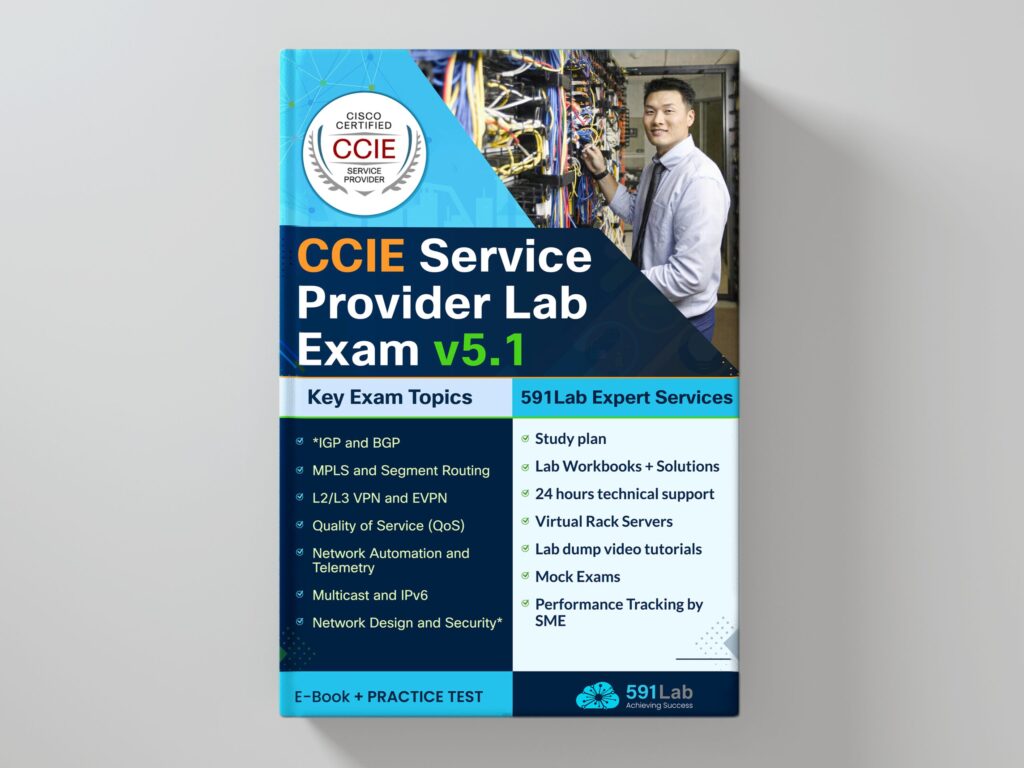If you’re aiming for one of the most prestigious certifications in the networking world—the CCIE Service Provider—you already know it’s not a walk in the park. It requires deep technical expertise, hours of hands-on practice, and a structured preparation strategy. But the good news? With the right tools, guidance, and mindset, you can absolutely conquer the CCIE SP exam and earn that elite certification.
Whether you’re just getting started or refining your study plan, this guide breaks down exactly how to prepare for the CCIE Service Provider exam in 2025—what to study, how to study, and which resources will help you succeed.

Understand the CCIE Service Provider Exam Format
Before you dive into technical topics, you need a clear understanding of what the exam entails. The CCIE SP certification process includes two parts:
- The Qualifying Exam (350-501 SPCOR) – This 120-minute written exam tests your theoretical knowledge across core service provider technologies like routing protocols, QoS, multicast, and network automation.
- The Hands-On Lab Exam – An intense 8-hour practical exam where you’ll design, implement, and troubleshoot complex service provider network solutions in a simulated environment.
In 2025, Cisco has made it clear that the lab isn’t just about command memorization—it’s about applying knowledge in real-world scenarios. That means your prep has to be both deep and hands-on.
Start With the Blueprint
One of the best ways to get aligned with the exam is by carefully studying the Cisco CCIE SP exam blueprint. This document outlines every topic covered and breaks them down into categories such as:
- Core Routing (IS-IS, OSPF, BGP, MPLS)
- Layer 2 and Layer 3 services
- QoS and Traffic Engineering
- Segment Routing
- Network Assurance and Telemetry
- Automation and Programmability (YANG, NETCONF, Python, etc.)
Pro tip: Treat the blueprint as your checklist. As you progress through your study plan, track what you’ve mastered and what still needs work.
Build a Structured Study Plan
With such a vast amount of material to cover, organization is everything. Aim to spread your prep over several months (6–12 months is typical) and divide your study time into manageable weekly or daily goals.
Here’s a sample weekly breakdown:
- Week 1–4: Focus on foundational protocols like OSPF, IS-IS, and BGP.
- Week 5–8: Dive into MPLS, L2VPN, and L3VPN technologies.
- Week 9–12: Master QoS, segment routing, and advanced multicast.
- Week 13–16: Tackle network automation and programmability tools.
- Week 17+: Intensive lab practice and timed mock labs.
Be flexible, but consistent. Block out distraction-free study hours during the week and dedicate your weekends to deeper lab sessions or reviews.
Invest in the Right Tools and Labs
Theoretical knowledge alone won’t cut it—you must get your hands dirty in the lab. Here are some of the most effective lab environments and tools to support your learning:
✅ Virtual Lab Solutions
- Cisco Modeling Labs (CML)
- EVE-NG or GNS3 with service provider images
- VIRL or remote rack rentals from providers like INE or IPexpert
✅ Study Resources
- Cisco Press books tailored to SP topics
- INE CCIE SP Learning Paths
- Narbik Kocharians’ Workbooks
- Cisco DevNet for programmability practice
✅ Automation Tools
- Postman for API testing
- Python with Netmiko/NAPALM
- Ansible for network configuration automation
Don’t just passively read through configurations—build labs, break things, and troubleshoot. That’s where true understanding is forged.
Learn How to Troubleshoot Like a Pro
Troubleshooting is a huge part of the CCIE lab. Don’t just focus on configuring networks—learn to recognize and resolve issues quickly. As you practice:
- Deliberately misconfigure protocols and try to fix them.
- Use debugs, show commands, and logging to diagnose problems.
- Time yourself solving troubleshooting tickets under pressure.
Speed and accuracy are key. The lab exam is timed, and every second counts.
Join a Study Group or Mentorship Program
Preparing for the CCIE can feel like a lonely road—but it doesn’t have to be. Joining an active study group or community can offer support, fresh perspectives, and shared resources.
Look for:
- Cisco Learning Network forums
- Discord or Slack study groups
- LinkedIn CCIE communities
- Webinars and live training sessions
You can also find mentors who have already passed the exam—they’ll help you stay motivated and avoid common mistakes.
Don’t Neglect Your Soft Skills
While technical skill is crucial, don’t overlook the mental side of preparation:
- Stay consistent: Make studying a daily habit.
- Practice under pressure: Simulate exam conditions.
- Take breaks: Avoid burnout with proper rest and downtime.
- Stay positive: Confidence and perseverance are powerful assets.
Final Thoughts: You’ve Got This
The CCIE Service Provider exam is tough—but not impossible. With a smart, focused strategy and the right tools in your arsenal, you can absolutely rise to the challenge. Remember, every configuration you break and fix, every concept you master, and every lab you complete brings you one step closer to that coveted CCIE number.
So keep going, stay curious, and trust the process. Your CCIE Service Provider badge is waiting—and it’s going to be worth every ounce of effort.


